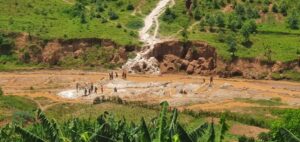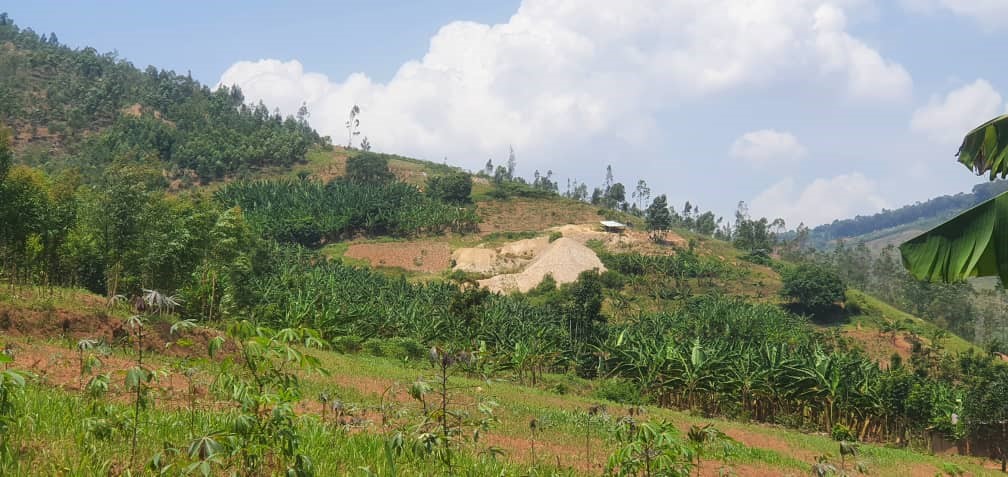KAMONYI – Epiphanie Nabonurwumwe ’s house of 50 years in Kamonyi District, south of the capital Kigali, lies in ruins. Illegal miners searching for tin burrowed so deep beneath the house that it collapsed, said the 65-year-old grandmother, who was forced to leave her home because the structure is no longer safe. She now stays in a house rented by her son.
Just a few meters from Nabonurwumwe’s home, a deep pit cuts into the earth and leads under her home. The men mined for six months before they gave up and left, she said.
“Can you see that I have no roof and now have to seek shelter?” said Nabonurwumwe, pointing to what is left of her home built on a hillside among banana trees..
“They started digging below Nizeyimana’s land and eventually reached my house… I reported it to the village authorities, but they just stopped him, and once it was forgotten, he continued mining,” she added.
Unlike Nabonurwumwe, her neighbour Jack Nizeyimana still lives in his severely damaged home.
Nizeyimana said the miners promised to pay him Rwf 50,000 (US $35) to test the soil for traces of tin, which is used globally in products like mobile phones, electric cars and solar panels.
“A businessman came and started mining, then dug under my house, causing it to collapse, and the other part cracked,” said Nizeyimana, a farmer in his 40’s. “The district authorities came, but it didn’t help,” he added.

Photo by Rosine
Illegal mining in mineral-rich Kamonyi District has mushroomed since 2022, driven by demand and higher prices for some minerals. The miners are usually young men between the ages of 18 and 30. They often refer to themselves as “abahebyi,” which means those who risk their lives.
The mining is hard work but lucrative, said a 25-year-old illegal miner, who asked to speak on condition of anonymity to avoid being caught.
“If you mine tirelessly, you can extract up to one kilogram of minerals in a day or even more,” he said. “A kilogram is sold for about Rwf 40,000. Over 20 illegal miners are working on a single site,” he added.
Kamonyi Mayor Sylivere Nahayo acknowledged the challenges with trying to tackle illegal mining operations.
“We monitor mining activities daily. When issues arise, we address them,” he said in an interview, adding: “However, some abahebyi continue their operations unlawfully, causing damage.”
He denied knowing about damages to the homes of Nabonurwumwe and her neighbours.
“I couldn’t identify the individuals you mentioned by name, but when they come to us, we will assist them by examining their issues,” he said in an interview. “For matters related to mining or land, we are required to visit the location to assess the situation firsthand.”
To crack down on illegal mining, Rwanda last year tightened penalties for those caught mining illegally. Companies caught mining illegally could face fines between Rwf 60 million and Rwf 80 million, much more than the Rwf 1 million to Rwf 5 million under an earlier mining law.
Still, illegal mining and trafficking in minerals and metals remains a major problem. The Rwanda Investigation Bureau estimated that the country lost around $386 million in 2022, $550 million in 2023, and risked losing as much as $650 million in 2024 from illegal mining.
Compare this with Rwanda’s mineral exports which rose to over $1.1 billion in 2023, up from $722 million in 2022, representing a growth of 43%, according to a statement by the Rwanda Mines, Petroleum and Gas Board (RMB) on February 15, 2024.
Emmanuel Ruziga, an economic analyst, said illegal mineral extraction not only hurt Rwanda’s economy by cutting into government mining revenues, it also contributed to tax evasion.
“Illegal mining activities bypass government oversight, meaning the proceeds from these operations are not captured within the national tax system, he said in an interview. As a result, the state loses vital revenue that could have supported public spending and national development,” said Ruziga.

Photo by Rosine
Rwanda has enormous gold, tungsten, tantalum and tin resources. In 2023, the RMB said 89 illegal mines had been identified including 32 in the Eastern province, 20 in the Southern province, 18 in the Northern Province, 17 in the Western province, and two in Kigali.
The project received support from the Thomson Reuters Foundation as part of its global work aimed at strengthening free, fair and informed societies. Any financial assistance or support provided to the journalist has no editorial influence. The content of this article belongs solely to the author and is not endorsed by or associated with the Thomson Reuters Foundation, Thomson Reuters, Reuters, nor any other affiliates.


